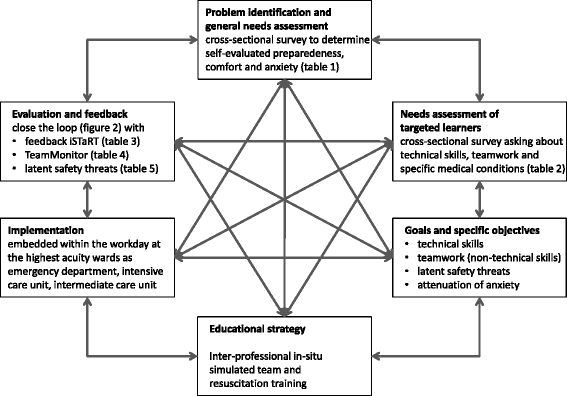Inter-professional in-situ simulated team and resuscitation training for patient safety: Description and impact of a programmatic approach
- PMID: 26511721
- PMCID: PMC4625566
- DOI: 10.1186/s12909-015-0472-5
Inter-professional in-situ simulated team and resuscitation training for patient safety: Description and impact of a programmatic approach
Abstract
Background: Inter-professional teamwork is key for patient safety and team training is an effective strategy to improve patient outcome. In-situ simulation is a relatively new strategy with emerging efficacy, but best practices for the design, delivery and implementation have yet to be evaluated. Our aim is to describe and evaluate the implementation of an inter-professional in-situ simulated team and resuscitation training in a teaching hospital with a programmatic approach.
Methods: We designed and implemented a team and resuscitation training program according to Kern's six steps approach for curriculum development. General and specific needs assessments were conducted as independent cross-sectional surveys. Teamwork, technical skills and detection of latent safety threats were defined as specific objectives. Inter-professional in-situ simulation was used as educational strategy. The training was embedded within the workdays of participants and implemented in our highest acuity wards (emergency department, intensive care unit, intermediate care unit). Self-perceived impact and self-efficacy were sampled with an anonymous evaluation questionnaire after every simulated training session. Assessment of team performance was done with the team-based self-assessment tool TeamMonitor applying Van der Vleuten's conceptual framework of longitudinal evaluation after experienced real events. Latent safety threats were reported during training sessions and after experienced real events.
Results: The general and specific needs assessments clearly identified the problems, revealed specific training needs and assisted with stakeholder engagement. Ninety-five interdisciplinary staff members of the Children's Hospital participated in 20 in-situ simulated training sessions within 2 years. Participant feedback showed a high effect and acceptance of training with reference to self-perceived impact and self-efficacy. Thirty-five team members experiencing 8 real critical events assessed team performance with TeamMonitor. Team performance assessment with TeamMonitor was feasible and identified specific areas to target future team training sessions. Training sessions as well as experienced real events revealed important latent safety threats that directed system changes.
Conclusions: The programmatic approach of Kern's six steps for curriculum development helped to overcome barriers of design, implementation and assessment of an in-situ team and resuscitation training program. This approach may help improve effectiveness and impact of an in-situ simulated training program.
Figures


References
-
- Reeves S. Interprofessional Teamwork for Health and Social Care. Chichester, West Sussex. Wiley-Blackwell: Ames, Iowa; 2010.
MeSH terms
LinkOut - more resources
Full Text Sources
Other Literature Sources
Medical

